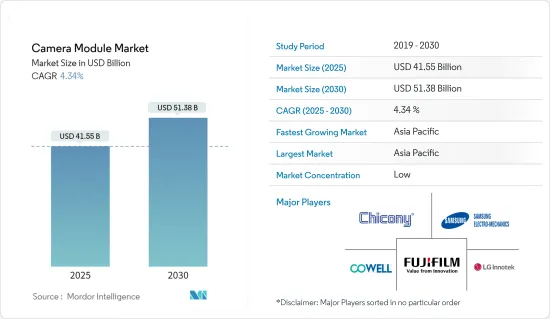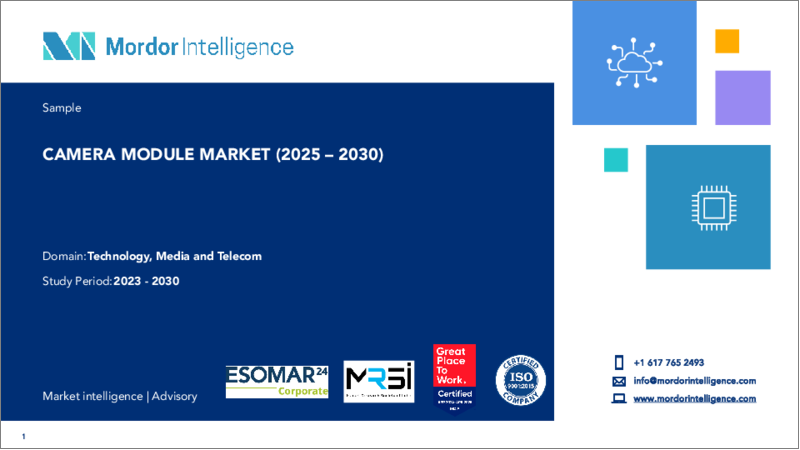|
|
市場調査レポート
商品コード
1687731
カメラモジュール- 市場シェア分析、産業動向・統計、成長予測(2025~2030年)Camera Module - Market Share Analysis, Industry Trends & Statistics, Growth Forecasts (2025 - 2030) |
||||||
カスタマイズ可能
適宜更新あり
|
|||||||
| カメラモジュール- 市場シェア分析、産業動向・統計、成長予測(2025~2030年) |
|
出版日: 2025年03月18日
発行: Mordor Intelligence
ページ情報: 英文 194 Pages
納期: 2~3営業日
|
全表示
- 概要
- 目次
カメラモジュールの市場規模は、2025年に415億5,000万米ドルと推定され、予測期間(2025~2030年)のCAGRは4.34%で、2030年には513億8,000万米ドルに達すると予測されます。
出荷数量では、2025年の80億8,000万個から2030年には109億2,000万個に成長すると予測され、予測期間(2025~2030年)のCAGRは6.20%です。

カメラモジュール市場:包括的分析
主要ハイライト
- ADAS(先進運転支援システム)の急増:カメラモジュール市場は、主に自動車のADAS(先進運転支援システム)需要の高まりにより、大きな成長を遂げています。前方カメラシステムは、車線維持支援、自動緊急ブレーキ、アダプティブクルーズコントロールなどの安全機能に先進的センシング機能を提供することで、ADASにおいて重要な役割を果たしています。ADASへの依存度が高まるにつれ、産業各社は研究開発(R&D)や提携に多額の投資を行うようになっています。例えば、Xilinx Inc.とMotovisは、Xilinx Automotive ZynqシステムオンチッププラットフォームとMotovisの畳み込みニューラルネットワークIPを統合し、前方カメラシステムによる車両知覚と制御を実現するために協業しました。
- Sunny Optical TechnologyとValens Semiconductorは、MIPI A-PHY対応チップセットをADAS向け次世代カメラモジュールに組み込むことで提携しました。
- Magna Internationalはサラウンドビューカメラと電子制御ユニットを発売し、3Dサラウンドビュー技術を消費者により身近なものにしました。
- Foresight Autonomous Holdingsは、ADAS性能を強化するため、日本のTier 1サプライヤーと共同概念実証に調印。
- セキュリティカメラの普及:住宅と商業施設の両方でセキュリティカメラの使用が増加していることも、カメラモジュール市場を牽引する主要因です。この需要は、IoTベースのセキュリティシステムの採用と相まって、犯罪やテロの脅威が増大していることが背景にあります。例えば、米国におけるモニタリングカメラの設置台数は、2018年の7,000万台から2021年には8,500万台へと21%急増しました。同様に、英国のセキュリティシステムサービスは、2019年の13億5,190万米ドルから2024年までに15億9,884万米ドルの売上を生み出すと予測されています。
- 韓国では、公共CCTVの設置台数が200%増加し、2021年には145万8,465台に達しました。
- グルグラム都市開発公社は、スマートシティ構想の一環として、200か所に1,000台のモニタリングカメラを設置する予定です。
- モントリオール警察は、凶悪犯罪率の上昇に対応するため、9台のモニタリングカメラを追加設置しました。
- 技術進歩がイノベーションを促進カメラモジュール市場は、特にモバイル撮影において急速な技術進歩を遂げています。O-Filmのようなメーカーが超薄型のペリスコープレンズモジュールを発表し、ペリスコープモジュールはフラッグシップスマートフォンの標準機能となりました。さらに、ウエハーレベルガラス(WLG)+プラスチックレンズは、ハイブリッドWLGカメラレンズを組み込んだXiaomiのRedmi K40 Gaming Editionに見られるように、人気を集めています。
- Oppoは、従来の望遠センサよりも優れた画質を提供する連続光学ズームレンズを発表しました。
- Appleは、プリズム、レンズアレイ、イメージセンサを使用した潜望鏡カメラシステムの特許を取得しました。
- Vision Componentsは、高解像度と高速フレームレートを特徴とする医療技術用途用の新しいMIPIカメラモジュールを発表しました。
- 市場機会と今後の成長:小型カメラモジュール市場は、スマートフォン、自動車、医療などの用途の進歩により、大きく成長しようとしています。Ericssonによると、世界のスマートフォン市場は拡大しており、世界のスマートフォン契約数は2021年の6兆2,590億件から2027年には7兆6,900億件に拡大すると予想されています。自動車セグメントでも、特にリアカメラとADAS前方カメラの採用が増加しており、大きなビジネス機会となっています。
- 360度ビュー、キャビン・モニタリング、e-mirror用途の需要により、自動車1台当たりの平均カメラ台数は増加しています。
- OmniVisionとValens Semiconductorは共同で、自動車向けのMIPI A-PHY準拠カメラソリューションを開発しました。
- 医療産業も恩恵を受け、OmniVisionは内視鏡検査用の最小医療用CMOSイメージセンサを発表しました。
カメラモジュール市場動向
イメージセンサセグメントがコンポーネントを席巻
- セグメント概要:イメージセンサセグメントはカメラモジュール市場の大部分を占め、2021年の市場総売上の50.16%を占めます。最大のコンポーネントセグメントとして、イメージセンサは様々な産業のカメラモジュールで重要な役割を果たしています。
- 市場規模と成長:2027年までに、イメージセンサセグメントは300億8,000万米ドルに達すると予測され、2022~2027年までの年間平均成長率(CAGR)は6.71%です。この成長は、カメラモジュールのエコシステムにおけるイメージセンサの継続的な重要性を反映しています。
- 技術の進歩:高解像度と低照度性能の向上に対する需要が、イメージセンサの技術進化を促しています。Canonの単光子アバランシェ・ダイオード(SPAD)センサの開発はその一例であり、低照度下での高画質撮影を可能にしています。
- 競合情勢:Sony Groupのような主要企業間の激しい競争は、絶え間ない技術革新の原動力となっています。Sonyは、戦略的パートナーシップや、スマートフォン、自動車、新興技術向けの先進センサの開発を通じて、市場のリーダーであり続けています。
- 産業用途:イメージセンサの採用は従来のカメラ用途を超え、特にADASや自律走行車が高品質センサを必要とする自動車セグメントで拡大しています。OmniVisionとValens Semiconductorは自動車グレードのカメラソリューションを共同開発し、自動車セグメントの重要性が高まっていることを示しています。
アジア太平洋はカメラモジュール市場成長の震源地
- 地域の優位性:アジア太平洋はカメラモジュール市場で最も急成長している最大セグメントであり、CAGR 10.77%で2027年までに389億4,000万米ドルに達すると予想されます。
市場促進要因
- 製造拠点:中国、韓国、台湾を中心とするこの地域のエレクトロニクスと半導体製造能力が、カメラモジュール生産を牽引しています。
- スマートフォンの普及:インドや中国など人口の多い国々でのスマートフォンの急速な普及がカメラモジュールの需要を促進しており、中国では2021年にモバイルインターネットユーザーが10億人を超えると報告されています。
- 自動車セクターの成長:日本、韓国、中国などの自動車市場の成長は、ADASとカメラモジュールの需要を加速させています。
- 政府の取り組み:インドの「Make in India」イニシアティブのような支援施策が、カメラモジュール製造への投資を誘致しています。
- 産業の開発:主要企業はこの地域に多額の投資を行っています。Samsungは中国からインドに工場を移転し、同国の製造目標に沿う一方、OPPOは3秒に1台のスマートフォンを生産できる工場を設立しました。
- 技術革新:OFILM Groupのようなアジア太平洋企業は技術革新の最前線にあり、世界市場での競合を維持するために研究機関を設立しています。
カメラモジュール市場概要
カメラモジュール市場は高度に統合されており、LG Innotek、Sunny Optical、O-Filmなどの大手世界企業が2021年の市場シェア75%を占めています。Luxvisions、Chicony、Mcnexのような小規模参入企業は、合計で残りの市場シェアの34.6%を占めています。
イノベーションと垂直統合:市場リーダーは研究開発と垂直統合を重視しています。例えば、LG Innotekは年間売上高の5%以上を研究開発に投資しており、10億7,000万米ドルを投資して生産能力を増強する計画です。Sunny Opticalは、Fuji Tianjinを買収し、独自の精密光学会社を設立することで、垂直統合を強化しています。
将来の成功のための戦略:企業は競合を維持するために、技術の進歩、戦略的パートナーシップ、市場の多様化に投資しなければならないです。Sunny OpticalはValens Semiconductorと提携し、ADAS対応カメラモジュールを開発しています。さらに、企業は自動車やIoTなどの新興セグメントに注力する一方、小型化された高性能カメラモジュールの需要拡大に対応するために製造プロセスを最適化する必要があります。
その他の特典
- エクセル形式の市場予測(ME)シート
- 3ヶ月間のアナリストサポート
目次
第1章 イントロダクション
- 調査の前提条件と市場定義
- 調査範囲
第2章 調査手法
第3章 エグゼクティブサマリー
第4章 市場洞察
- 市場概要
- 産業の魅力-ポーターのファイブフォース分析
- 供給企業の交渉力
- 買い手の交渉力
- 新規参入業者の脅威
- 代替品の脅威
- 競争企業間の敵対関係の強さ
- 産業バリューチェーン分析
- COVID-19の産業への影響評価
- 価格動向分析
- 超小型カメラモジュールの力学
- 様々な用途におけるカメラモジュール・サイズの進化
- 各ベンダーが提供する解像度と製品マッピング
- 解像度対コスト分析
第5章 市場力学
- 市場促進要因
- 自動車のADAS(先進運転支援システム)に対する市場促進要因の増加
- 家庭や商業施設におけるセキュリティカメラ使用の増加
- 市場抑制要因
- 複雑な製造とサプライチェーンの課題
- 技術進化の動向
- コンポーネントによる技術進歩
- 最終製品あたりの平均カメラ数-スマートフォン対軽自動車
自動車/携帯電話におけるカメラの進化
第6章 市場セグメンテーション
- コンポーネント別
- イメージセンサ
- レンズ
- カメラモジュールアセンブリ
- VCMサプライヤー(AFとOIS)
- 用途別
- モバイル
- 民生用電子機器(モバイルを除く)
- 自動車
- 医療
- セキュリティ
- 産業用
- 地域別
- 北米
- 欧州
- アジア
- オーストラリア・ニュージーランド
- ラテンアメリカ
- 中東・アフリカ
第7章 ベンダー市場シェア分析
- カメラモジュールベンダー市場シェア
- イメージセンサ(CIS)ベンダーランキング
- レンズセットベンダーランキング
第8章 競合情勢
- 企業プロファイル
- Chicony Electronics Co. Ltd
- Cowell E Holdings Inc.
- Fujifilm Corporation
- LG Innotek Co. Ltd
- Samsung Electro-Mechanics Co. Ltd
- Primax Electronics Ltd
- LuxVisions Innovation Limited(Lite-On Technology Corporation)
- Sharp Corporation
- Sony Group Corporation
- STMicroelectronics NV
- Sunny Optical Technology(Group)Company Limited
- AMS OSRM AG
- On Semiconductor(Semiconductor Components Industries LLC)
- OFILM Group Co. Ltd
- OmniVision Technologies Inc.
第9章 投資分析
第10章 市場機会と将来の成長
The Camera Module Market size is estimated at USD 41.55 billion in 2025, and is expected to reach USD 51.38 billion by 2030, at a CAGR of 4.34% during the forecast period (2025-2030). In terms of shipment volume, the market is expected to grow from 8.08 billion units in 2025 to 10.92 billion units by 2030, at a CAGR of 6.20% during the forecast period (2025-2030).

Camera Module Market: A Comprehensive Analysis
Key Highlights
- Surge in Advanced Driver Assistance Systems: The camera module market is experiencing significant growth, primarily due to the rising demand for Advanced Driver Assistance Systems (ADAS) in vehicles. Forward camera systems play a crucial role in ADAS by providing advanced sensing capabilities for safety features like lane-keeping assistance, automatic emergency braking, and adaptive cruise control. The increasing reliance on ADAS is prompting industry players to invest heavily in research and development (R&D) and collaborations. For example, Xilinx Inc. and Motovis collaborated to integrate the Xilinx Automotive Zynq system-on-chip platform with Motovis' convolutional neural network IP for vehicle perception and control through forward camera systems.
- Sunny Optical Technology and Valens Semiconductor partnered to incorporate MIPI A-PHY-compliant chipsets into next-generation camera modules for ADAS applications.
- Magna International launched surround-view cameras and electronic control units, making 3D surround-view technology more accessible to consumers.
- Foresight Autonomous Holdings signed a joint proof of concept with a Japanese Tier One supplier to enhance ADAS performance.
- Rising Security Camera Adoption: The growing use of security cameras in both residential and commercial settings is another major factor driving the camera module market. This demand is fueled by the increasing threat of crime and terrorism, coupled with the adoption of IoT-based security systems. For example, the number of installed surveillance cameras in the U.S. surged by 21%, from 70 million in 2018 to 85 million in 2021. Similarly, security system services in the U.K. are projected to generate USD 1,598.84 million in revenue by 2024, up from USD 1,351.9 million in 2019.
- South Korea saw a 200% increase in public CCTV installations, reaching 1,458,465 cameras in 2021.
- Gurugram Metropolitan Development Authority plans to install 1,000 surveillance cameras across 200 locations as part of its smart city initiative.
- Montreal police installed nine additional security cameras in response to rising violent crime rates.
- Technological Advancements Driving Innovation: The camera module market is experiencing rapid technological advancements, especially in mobile photography. Periscope modules have become standard features in flagship smartphones, with manufacturers like O-Film unveiling ultra-thin periscope lens modules. Additionally, Wafer Level Glass (WLG) + Plastic lenses are gaining traction, as seen in Xiaomi's Redmi K40 Gaming Edition, which incorporates a hybrid WLG camera lens.
- Oppo launched a continuous optical zoom lens offering superior image quality over conventional telephoto sensors.
- Apple was granted a patent for a periscope camera system using prisms, a lens array, and an image sensor.
- Vision Components introduced new MIPI camera modules for medical technology applications, featuring high image resolutions and fast frame rates.
- Market Opportunities and Future Growth: The compact camera module market is on the verge of substantial growth, driven by advancements across applications like smartphones, automotive, and healthcare. The global smartphone market is expanding, with worldwide smartphone subscriptions expected to grow from 6,259 billion in 2021 to 7,690 billion by 2027, according to Ericsson. The automotive sector also presents significant opportunities, particularly with the rising adoption of rear cameras and ADAS forward cameras.
- The average number of cameras per car is increasing, driven by the demand for 360-degree views, cabin monitoring, and e-mirror applications.
- OmniVision and Valens Semiconductor collaborated to develop a MIPI A-PHY-compliant camera solution for automotive applications.
- The healthcare industry is also benefiting, with OmniVision launching its smallest medical CMOS image sensor for endoscopy procedures.
Camera Module Market Trends
Image Sensor Segment Dominating the Component Landscape
- Segment Overview: The image sensor segment commands a significant portion of the camera module market, contributing to 50.16% of the total market revenue in 2021. As the largest component segment, image sensors play a vital role in camera modules across various industries.
- Market Size and Growth: By 2027, the image sensor segment is projected to reach USD 30.08 billion, with a compound annual growth rate (CAGR) of 6.71% from 2022 to 2027. This growth reflects the continued importance of image sensors in the camera module ecosystem.
- Technological Advancements: The demand for higher resolution and better low-light performance is driving technological evolution in image sensors. Canon's development of a single-photon avalanche diode (SPAD) sensor exemplifies this, allowing high-quality image capture in low-light conditions.
- Competitive Landscape: Intense competition among key players like Sony Group Corporation drives continuous innovation. Sony remains a market leader through strategic partnerships and the development of advanced sensors for smartphones, automotive, and emerging technologies.
- Industry Applications: The adoption of image sensors is expanding beyond traditional camera uses, particularly in the automotive sector, where ADAS and autonomous vehicles require high-quality sensors. OmniVision and Valens Semiconductor collaborated to develop automotive-grade camera solutions, illustrating the automotive sector's growing significance.
Asia-Pacific The Epicenter of Camera Module Market Growth
- Regional Dominance: The Asia-Pacific region is the fastest-growing and largest segment of the camera module market, expected to reach USD 38.94 billion by 2027 with a CAGR of 10.77%.
Market Drivers:
- Manufacturing Hub: The region's electronics and semiconductor manufacturing capabilities, particularly in China, South Korea, and Taiwan, drive camera module production.
- Smartphone Penetration: Rapid smartphone adoption in populous countries like India and China is fueling demand for camera modules, with China reporting over 1 billion mobile internet users in 2021.
- Automotive Sector Growth: The growing automotive markets in countries like Japan, South Korea, and China are accelerating demand for ADAS and camera modules.
- Government Initiatives: Supportive policies like India's "Make in India" initiative are attracting investments in camera module manufacturing.
- Industry Developments: Key players are investing heavily in the region. Samsung shifted its factory from China to India, aligning with the country's manufacturing goals, while OPPO established a plant capable of producing one smartphone every three seconds.
- Technological Innovation: Asia-Pacific companies like OFILM Group Co. Ltd are at the forefront of innovation, establishing research institutes to maintain a competitive edge in the global market.
Camera Module Market Overview
The camera module market is highly consolidated, with leading global players such as LG Innotek, Sunny Optical, and O-Film commanding a 75% market share in 2021. Smaller players like Luxvisions, Chicony, and Mcnex collectively account for 34.6% of the remaining market share.
Innovation and Vertical Integration: Market leaders emphasize R&D and vertical integration. For instance, LG Innotek invests over 5% of its annual revenue in R&D and plans to increase production capacity with a USD 1.07 billion investment. Sunny Optical has bolstered its vertical integration by acquiring Fuji Tianjin and establishing its own precision optics company.
Strategies for Future Success: Companies must invest in technological advancements, strategic partnerships, and market diversification to remain competitive. Sunny Optical's partnership with Valens Semiconductor to develop ADAS-compliant camera modules exemplifies this. Moreover, companies should focus on emerging sectors like automotive and IoT, while optimizing manufacturing processes to meet growing demand for miniaturized, high-performance camera modules.
Additional Benefits:
- The market estimate (ME) sheet in Excel format
- 3 months of analyst support
TABLE OF CONTENTS
1 INTRODUCTION
- 1.1 Study Assumptions and Market Definition
- 1.2 Scope of the Study
2 RESEARCH METHODOLOGY
3 EXECUTIVE SUMMARY
4 MARKET INSIGHTS
- 4.1 Market Overview
- 4.2 Industry Attractiveness - Porter's Five Forces Analysis
- 4.2.1 Bargaining Power of Suppliers
- 4.2.2 Bargaining Power of Buyers
- 4.2.3 Threat of New Entrants
- 4.2.4 Threat of Substitute Products
- 4.2.5 Intensity of Competitive Rivalry
- 4.3 Industry Value Chain Analysis
- 4.4 Assessment of Impact of COVID-19 on the Industry
- 4.5 Price Trend Analysis
- 4.6 Ultra Small Camera Module Dynamics
- 4.6.1 Evolution of Camera Module Size Across Various Applications
- 4.6.2 Product Mapping with Resolutions Offered by Various Vendors
- 4.6.3 Resolution Vs. Cost Analysis
5 MARKET DYNAMICS
- 5.1 Market Drivers
- 5.1.1 Increased Market Demand for Advanced Driver Assistance Systems in Vehicles
- 5.1.2 Increased Use of Security Cameras in Households and Commercial Establishments
- 5.2 Market Restraints
- 5.2.1 Complicated Manufacturing and Supply Chain Challenges
- 5.3 Technology Evolution Trends
- 5.3.1 Component-wise Technological Advancements
- 5.3.2 Average Number of Cameras Per End-product - Smartphones Vs. Light
Vehicles / Camera Evolution in a Mobile Phone
6 MARKET SEGMENTATION
- 6.1 By Component
- 6.1.1 Image Sensor
- 6.1.2 Lens
- 6.1.3 Camera Module Assembly
- 6.1.4 VCM Suppliers (AF & OIS)
- 6.2 By Application
- 6.2.1 Mobile
- 6.2.2 Consumer Electronics (Excl. Mobile)
- 6.2.3 Automotive
- 6.2.4 Healthcare
- 6.2.5 Security
- 6.2.6 Industrial
- 6.3 By Geography
- 6.3.1 North America
- 6.3.2 Europe
- 6.3.3 Asia
- 6.3.4 Australia and New Zealand
- 6.3.5 Latin America
- 6.3.6 Middle East and Africa
7 VENDOR MARKET SHARE ANALYSIS
- 7.1 Camera Module Vendor Market Share
- 7.2 Image Sensor (CIS) Vendor Ranking
- 7.3 Lens Set Vendor Ranking
8 COMPETITIVE LANDSCAPE
- 8.1 Company Profiles
- 8.1.1 Chicony Electronics Co. Ltd
- 8.1.2 Cowell E Holdings Inc.
- 8.1.3 Fujifilm Corporation
- 8.1.4 LG Innotek Co. Ltd
- 8.1.5 Samsung Electro-Mechanics Co. Ltd
- 8.1.6 Primax Electronics Ltd
- 8.1.7 LuxVisions Innovation Limited (Lite-On Technology Corporation)
- 8.1.8 Sharp Corporation
- 8.1.9 Sony Group Corporation
- 8.1.10 STMicroelectronics NV
- 8.1.11 Sunny Optical Technology (Group) Company Limited
- 8.1.12 AMS OSRM AG
- 8.1.13 On Semiconductor (Semiconductor Components Industries LLC)
- 8.1.14 OFILM Group Co. Ltd
- 8.1.15 OmniVision Technologies Inc.






